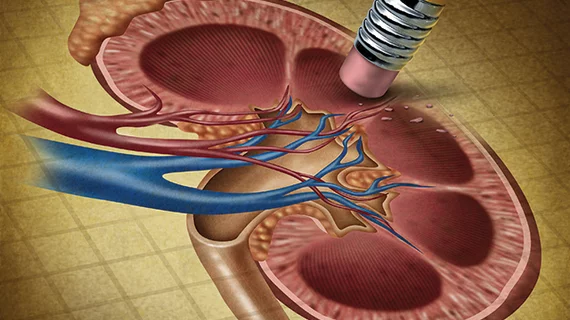AI looking handy with 3D abdominal ultrasound
Mayo Clinic researchers have demonstrated a deep learning model that can automatically segment kidneys and measure total kidney volumes using only 3D ultrasound images.
While the team concentrated on using the technique to assess a relatively uncommon condition—an inherited cyst-forming disorder called autosomal-dominant polycystic kidney disease (ADPKD)—they suggest the AI approach may have broader clinical implications.
Co-corresponding authors Bradley Erickson, MD, PhD, Timothy Kline, PhD, and colleagues trained the AI, a convolutional neural network, on multiple kidney ultrasound scans from 22 patients who had ADPKD. They tasked the tool with segmenting whole kidneys and measuring total kidney volumes.
For comparison purposes they also imaged the patients with the gold-standard modality, abdominal MRI, and pitted the AI against radiologists with expertise in abdominal image annotation and segmentation.
Reporting the results April 27 in Abdominal Radiology, the authors describe the neural network’s performance as “promising for auto-segmentation of kidneys and calculating total kidney volume,” adding that its yield was close in quality to the highly labor-intensive manual tracings and measurements traditionally performed by radiologists.
Further, with the help of AI, the ultrasound images compared well with those from the MRI scans, “suggesting [the approach] may be useful in populations where MRI is more challenging, such as children.”
The authors express hope that abdominal ultrasound with their AI technique will prove useful for managing issues with other organs.
“In the future, it could be interesting to add data from polycystic liver disease to the training data and perform segmentation on both kidneys and liver,” they write. “In general, liver volumes are often calculated in patients affected by total kidney volume and/or total liver volume. We believe that 3D ultrasound could also be applied to acquiring liver volumes, though this is beyond the scope of this present study.”
Since the kidney organ is located deep in the body, Erickson, Kline et al. comment,
… ultrasound technique could easily show artifacts in images due to air/fluid/tissue distribution in the body. The 2D ultrasound images have in general poorer resolution than MRI. Therefore, MRI is the preferred method for accurate measurement of renal volume compared with both ultrasound and CT. However, recent developments with the 3D ultrasound could help improve results with ultrasound imaging. With a large dataset, the model performance would improve, and 3D ultrasound imaging may become incorporated into the clinical practice for polycystic kidney disease monitoring.”
The study is available in full for free.
More coverage of abdominal imaging:
Abdominal MRI intervention helps drop respiratory motion and image quality degradation
Abdominal radiology must stay vigilant as almost 20% of COVID cases report with only GI symptoms
Follow-up imaging for incidental liver lesions on breast MRI rarely necessary
Reference:
Jaidip Jagtap, Adriana Gregory, Heather Homes, Darryl Wright, Marie Edwards, Zeynettin Akkus, Bradley Erickson and Timothy Kline, “Automated measurement of total kidney volume from 3D ultrasound images of patients affected by polycystic kidney disease and comparison to MR measurements.” Abdominal Radiology, April 27, 2022. DOI: doi.org/10.1007/s00261-022-03521-5

